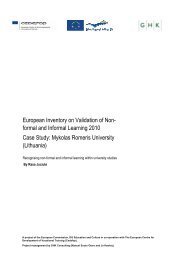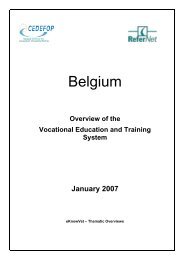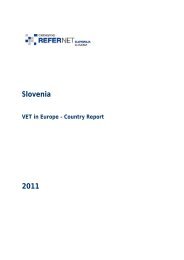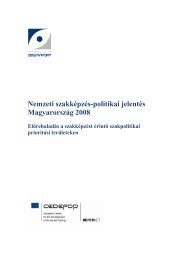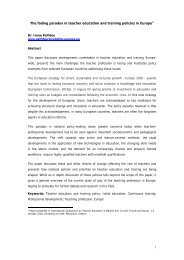PROFF – Professionalisation of VET teachers for the future - Europa
PROFF – Professionalisation of VET teachers for the future - Europa
PROFF – Professionalisation of VET teachers for the future - Europa
You also want an ePaper? Increase the reach of your titles
YUMPU automatically turns print PDFs into web optimized ePapers that Google loves.
3. Analysis <strong>of</strong> <strong>the</strong> case studies3.1. IntroductionIn this chapter we analyse <strong>the</strong> results <strong>of</strong> <strong>the</strong> 10 case studies selected <strong>for</strong> analysis. We begin bybriefly examining <strong>the</strong> background to <strong>the</strong> study: that is <strong>the</strong> way in which re<strong>for</strong>m is changingnational systems <strong>for</strong> vocational education and training and <strong>the</strong> new requirements this placeson teacher and trainer training (Section 3.2.). In Section 3.3. we examine how <strong>the</strong>se re<strong>for</strong>mshave changed <strong>the</strong> target groups <strong>for</strong> <strong>VET</strong>. In <strong>the</strong> following section (Section 3.4.) we examine<strong>the</strong> mix <strong>of</strong> skills and qualifications required by <strong>VET</strong> <strong>teachers</strong>, trainers and managers. Section3.5. looks at some <strong>of</strong> <strong>the</strong> strategies being used to provide <strong>the</strong>m while <strong>the</strong> following sectionexamines ‘modes <strong>of</strong> delivery’: <strong>the</strong> ways in which <strong>teachers</strong> and trainers are actually taught. InSection 3.6. we examine <strong>the</strong> crucial issue <strong>of</strong> accreditation <strong>for</strong> teacher and trainer training.Section 3.7. looks briefly at <strong>the</strong> question <strong>of</strong> funding <strong>for</strong> in-service training. Finally, Section3.8. examines <strong>the</strong> impact <strong>of</strong> <strong>the</strong> programmes studied in <strong>the</strong> case studies.3.2. <strong>VET</strong> re<strong>for</strong>m and new demands on teacher and trainertrainingThe programmes examined in <strong>the</strong> case studies were planned and carried out during a period <strong>of</strong>large-scale re<strong>for</strong>m in national <strong>VET</strong> systems. As a result <strong>of</strong> <strong>the</strong>se re<strong>for</strong>ms, modern European<strong>VET</strong> places a new emphasis on adult, lifelong learning. Courses have become more modular.It has become easier <strong>for</strong> students to obtain credit <strong>for</strong> previous learning (both <strong>for</strong>mal andin<strong>for</strong>mal).Often (especially in <strong>the</strong> Danish, Finnish and Norwegian case studies), <strong>the</strong>se changes have hada major impact on <strong>the</strong> way teaching is organised, requiring <strong>teachers</strong> and trainers to acquire<strong>the</strong>se new competences. In Finland, <strong>for</strong> example, traditional <strong>VET</strong> was school-based. A keygoal <strong>of</strong> <strong>VET</strong> re<strong>for</strong>m has been to improve <strong>the</strong> interaction between school and working life.This implies increased focus on on-<strong>the</strong>-job learning, i.e. inclusion <strong>of</strong> six months <strong>of</strong> on-<strong>the</strong>-joblearning and skills demonstrations in <strong>VET</strong> programmes. In Denmark, re<strong>for</strong>ms in <strong>the</strong> late1990s led to <strong>the</strong> introduction <strong>of</strong> new teaching methods with <strong>teachers</strong> being required to act astutors <strong>for</strong> trainees, counselling <strong>the</strong>m in <strong>the</strong>ir educational choices. Norway too has restructured<strong>VET</strong> programmes <strong>for</strong> school leavers. In <strong>the</strong> new system, trainees have to spend two years atschool followed by two years <strong>of</strong> apprenticeship. The new apprenticeship system hasstreng<strong>the</strong>ned <strong>the</strong> need to ensure <strong>the</strong> quality <strong>of</strong> workplace training and to guarantee <strong>the</strong>teaching skills <strong>of</strong> workplace instructors and in-company trainers. In Italy, a series <strong>of</strong> re<strong>for</strong>mshave created pressure <strong>for</strong> better coordination and integration between institutions <strong>of</strong>feringvocational training, placing new requirements on <strong>the</strong> skills <strong>of</strong> middle management. In17



